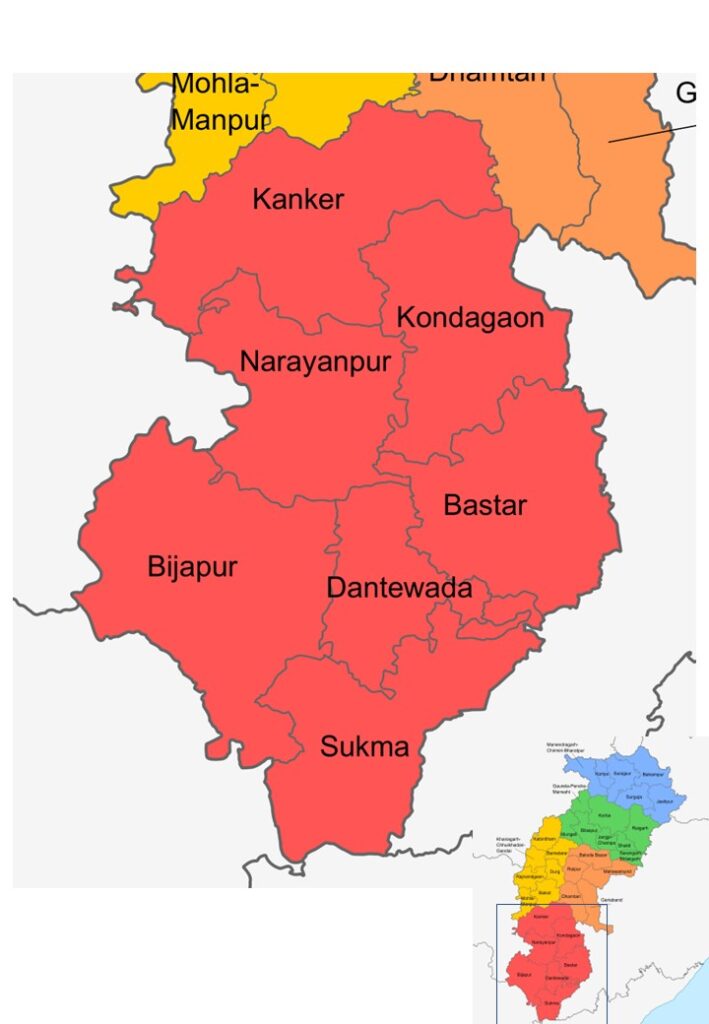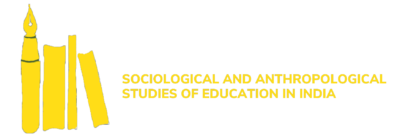Studying Up: Interviewing Elite Policy Makers
Sreejith Murali
Doctoral Research Scholar, Department of Humanities and Social Sciences,
Indian Institute of Technology Bombay, Mumbai

My initial visit to Bastar in the state of Chhattisgarh in 2017 was through my work as a Research Assistant in a project. The Bastar region currently consists of seven districts, a region larger in geographical area than the state of Kerala. Bastar districts has largest percentage of Schedule Tribe (ST) population in the state with approximately 67% of the population being ST with highest percentage of tribal population being in the districts of Bijapur (80%) and Sukma (83%). 2All data derived from the Statistical Abstract of Chhattisgarh 2011-12, Directorate of Economics and Statistics, Chhattisgarh (approximated to nearest whole number).The literacy rate in the 2011 for the region was around 55%, with wide variation across the districts, while Uttar Bastar (Kanker) had a literacy rate of 70%, the districts of Bijapur (41%) and Sukma (35%) were significantly low and other districts were around 50%. The state of education and literacy can be attributed to its historical state neglect weighing against extractive mining interests (Sundar, 2016). All the districts in the region come under what was termed as “Left Wing Extremist” and now as “Aspirational Districts”. From a security perspective these districts have active presence of Naxalites (members of Communist Party of India (Maoist) who are in a protracted war against Indian state) and in developmental perspective receiving welfare centered attention including in the field of education. Since the early 2000s, the region has seen increased presence of security forces and intensified conflict with Naxalites, which has also impacted educational policy formulations.
The project I was involved with was focused on evaluating the work of three NGOs there, giving me the opportunity to visit large residential schools called porta cabins (portable cabins) and smaller schools in dispersed villages. The infrastructure of the schools was strikingly different. For example, one of the porta cabins in Bijapur district had a large campus with concrete structures painted with cartoon characters, some of the teachers were local para-teachers (called anudeshaks) recruited for traveling to nearby villages and getting children admitted to schools and were also acting as teachers. On the other hand, one of the schools in an interior village could be reached only on foot. We walked for 3-4 hours through a forest since the roads leading to it were dug up and two streams on the way were overflowing. The one room school was empty when we reached it, the two teachers who accompanied us gathered some ten children from the village. The teachers who did not know Gondi, the local language, translated through a teenager speaking in Hindi and instructed the children to read from their textbooks.
The precarity of everyday schooling was evident when thinking about schools in interior villages. However, the nature of large residential schools also questioned my understanding of pedagogy and what a school should mean. This led to the question of how the state formulated schooling for a region like Bastar; an inquiry that I took up for my MPhil research. My positionality as an urban, upper caste male who did not understand the local languages did impact my research as I was mostly confined to towns in the region. Further, this limited my ability as a researcher to explore the historical and contemporary meaning of education for the various Adivasi communities in the region. Hence, I confined my research to how the capillaries of the state transacted educational policy in a region where many of the bureaucrats were not from the community.
One of the important aspects that I was trying to trace was how the bureaucrats made meaning regarding the core question of aims of education for the Adivasi children in the and how these meanings changed over time even though they were implementing educational policies that were framed in higher offices of their department. My aim was to understand the meaning-making behind policy decisions taken by local bureaucrats over the years and also critically read most relevant policy documents regarding the aspects of what the aims of education was, aspects of nature of schooling (like village schools and residential schools) and language of instruction. The method of data collection was mostly semi-structured interviews and critical reading of policy documents. I placed my research on the broad theoretical framework of policy sociology (Ball, 1993) and critical policy historiography (Gale, 2001).
My first contact with a senior administrator was through a well renowned Non-Governmental Organisation (NGO) in Bhopal. Thereafter I used the network provided by the administrator to make new contacts. The space of the interview varied with the availability and nature of work of the respondents. I interviewed two senior bureaucrats in their home over the course of three days each, I interviewed another senior bureaucrat over three days during his morning walks. Similarly, I interviewed a (then) serving civil servant during his evening walk in a park and later his office quarters. With the serving bureaucrats, some of the interviews happened in their offices, one of which I remember vividly. This required me to travel about 20 km or so from Raipur town (Chhattisgarh) to the Naya Raipur township which was being constructed at that time to house all the major government departments. The journey took about an hour and a half to two hours in a minibus on an extremely well laid out road leading to large buildings which looked more like the Information Technology offices in urban cities. There was no rush or noise associated with the bureaucracy, but a more (scaringly) organized layout of the offices. The bureaucrat from the Tribal Welfare Department gave me just 15-20 mins for a quick interview where he just referred to current schemes of the department. Other informal spaces of interview like houses or walks in the park allowed for a more detailed discussion which included questions on their perceptions of key issues concerning local education – aims of education in the local context, residential schools and language of instruction.
As Gewirtz & Ozga (1994) writes on their experience of interviewing policy elites, the access to mostly senior male bureaucrats was aided by the non-threatening nature of being a young researcher in the field. For Gewirtz & Ozga (1984) being young women who were not “important” allowed for the senior men who were the policy elites they interviewed to feel non-threatened but also was a challenge for them to be taken seriously. For me, a young male in the field who was a research scholar from a well-known university (Tata Institute of Social Sciences) allowed me access to the bureaucrats initially and later the inter-connectedness of the policy world allowed me to get in touch with other administrators – both retired and serving. I approached them with a naïve inquisitiveness and spoke in Hindi as much as possible (Hindi being the language of state administration). One of the bureaucrats appreciated me saying that I speak good Hindi despite coming from the south of the country.
Reflecting back, I understood through the research that the nature of bureaucratic understanding of policy and my oftentimes asking of the “what” questions led to responses which were process oriented, but it was the retired bureaucrats and few serving officials like a DIET official who went into their perspectives about the policies that were implemented in their interviews. As mentioned, I was not able to delve into the aspect of how the community there thought about educational aims and policies. But to get an overall political understanding, I interviewed two well-known political figures in the region and three other local political leaders and activists. These interviews were mostly conducted in their homes, excluding one activist who had come to Mumbai for a cultural function in a university.
What was evident from the interviews with the administrators was a change in the bureaucratic norm among the state officials from the Nehruvian era to the current times. The modern civil servant was also an entrepreneur who was interested in starting projects in education, health and livelihood which elevated their position within the services and led to awards from the government. New vocabularies for development also were dominant in the post-2000 policy landscape as the debate over what type of education was most relevant in Bastar was replaced with how policies of mass schooling in standardized language could be effectively operationalized within the context of armed conflict in the region, political economy of mining and the dispersed villages.
Footnotes
- 1Map retrieved from https://en.wikipedia.org/wiki/Bastar_division on 20th June 2023 (Not to scale)
- 2All data derived from the Statistical Abstract of Chhattisgarh 2011-12, Directorate of Economics and Statistics, Chhattisgarh (approximated to nearest whole number).
References
Ball, S. J. (1993). What is policy? Texts, trajectories and toolboxes. The Australian Journal of Education Studies, 13(2), 10-17
Gale, T. (2001). Critical policy sociology: Historiography, archaeology and genealogy as methods of policy analysis. Journal of education policy, 16(5), 379-393.
Gewirtz, S. & Ozga, J. (1994). Interviewing the Education Policy Elites. In: G. Walford (Ed.), Researching the Powerful in Education, London: Routledge, pp. 186-203.
Sundar, N. (2016). The burning forest: India’s war in Bastar. Juggernaut Books.
